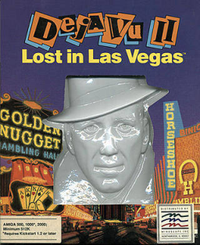- Deja Vu II: Lost in Las Vegas
-
Deja Vu II 
Cover art of Deja Vu II: Lost in Las VegasDeveloper(s) ICOM Simulations, Inc. Publisher(s) Mindscape Engine MacVenture Platform(s) Apple IIGS, Macintosh; Atari ST, CD-i, Commodore Amiga, Game Boy Color, PC, Pocket PC Release date(s) 1988 (Mac)
1989 (Amiga, Apple IIGS, Atari ST)
1990 (DOS)Genre(s) Adventure Mode(s) Single-player Media/distribution Two 3.5" 800k floppy disks (Mac) Deja Vu II: Lost in Las Vegas is a point-and-click adventure game, the sequel to Deja Vu: a Nightmare Comes True, set in the world of 1940s hard-boiled detective novels and movies. It was the last game made in the MacVenture series.
Contents
Gameplay
In this follow-up set in the late 1940s our hard-boiled hero Theodore 'Ace' Harding once again regains consciousness, this time in a room at the Las Vegas Lucky Dice Hotel and Casino. It soon becomes apparent that the Vegas mobster Tony Malone is missing a hundred grand ($112,000 in the Game Boy Color version) after the events that took place in Deja Vu (I): a Nightmare Comes True and that Ace has become the scapegoat.
Deja Vu II takes place in a sparsely populated Las Vegas reminiscent of the movie Bugsy, with just a few locations to explore. However, the player has the option to take the train to other cities including Chicago (if the player attempts to go to Los Angeles or St. Louis, the main character is killed by one of the antagonists, Stogie), where locations from Deja Vu I are revisited. Connections to this background story are well explained, and the game is completely playable by itself. In fact, there are situations where experience with Deja Vu I can be a disadvantage by creating certain expectations, for instance: the phone in the office at Joe's Bar is not openable in Deja Vu I, in Deja Vu II it contains an important item. To get to the office the player has to climb the fire ladder from the street, which is "too high" to reach in Deja Vu I.
Like the other MacVenture games there is a time limit, in this case the hitman Stogie Martin, who periodically reminds Ace to "come up with the dough". Although no longer affected by drug-induced amnesia (as in Deja Vu I), the player still experiences memory flashbacks when encountering certain environments or photographs.
Together with its predecessor Deja Vu II is considered by some fans to be the most difficult of these games and requires a lot of lateral thinking. As in Deja Vu I, the gameplay has a final part where evidence collected during the game has to be planted in the right places. This part is among the trickiest in the game, since the significance of each tidbit can be hard to assess.
Reception
Computer Gaming World, reviewing the Macintosh version, gave the game a negative review, saying, "Linear text games with "Guess The Commands" are right down on the bottom of my list of boring ways to waste time." An example pointed out in the review is that the command "operate - flashlight" wields the flashlight as a weapon, while "Flashlight - operate - flashlight" is needed to turn it on.[1]
See also
- Deja Vu: a Nightmare Comes True
References
- ^ Arneson, Dave (May 1989), "Seems Like Old Times", Computer Gaming World: 36, 50
External links
- Information and download for Mac version
- Information and download for Apple IIGS version
- Deja Vu I & II: The Casebooks of Ace Harding at MobyGames
- Deja Vu I & II: The Casebooks of Ace Harding Review at IGN.com
Deja Vu: a Nightmare Comes True (1985) · Uninvited (1986) · Shadowgate (1987) · Deja Vu II: Lost in Las Vegas (1988)Categories:- 1988 video games
- Adventure games
- Amiga games
- Apple IIGS games
- Atari ST games
- Cancelled Nintendo Entertainment System games
- CD-i games
- DOS games
- Game Boy Color games
- First-person adventures
- Mac OS games
- Organized crime video games
- Point-and-click adventure games
- Video game sequels
- Video games developed in the United States
- Video games set in the 1940s
- Video games set in Las Vegas
Wikimedia Foundation. 2010.
